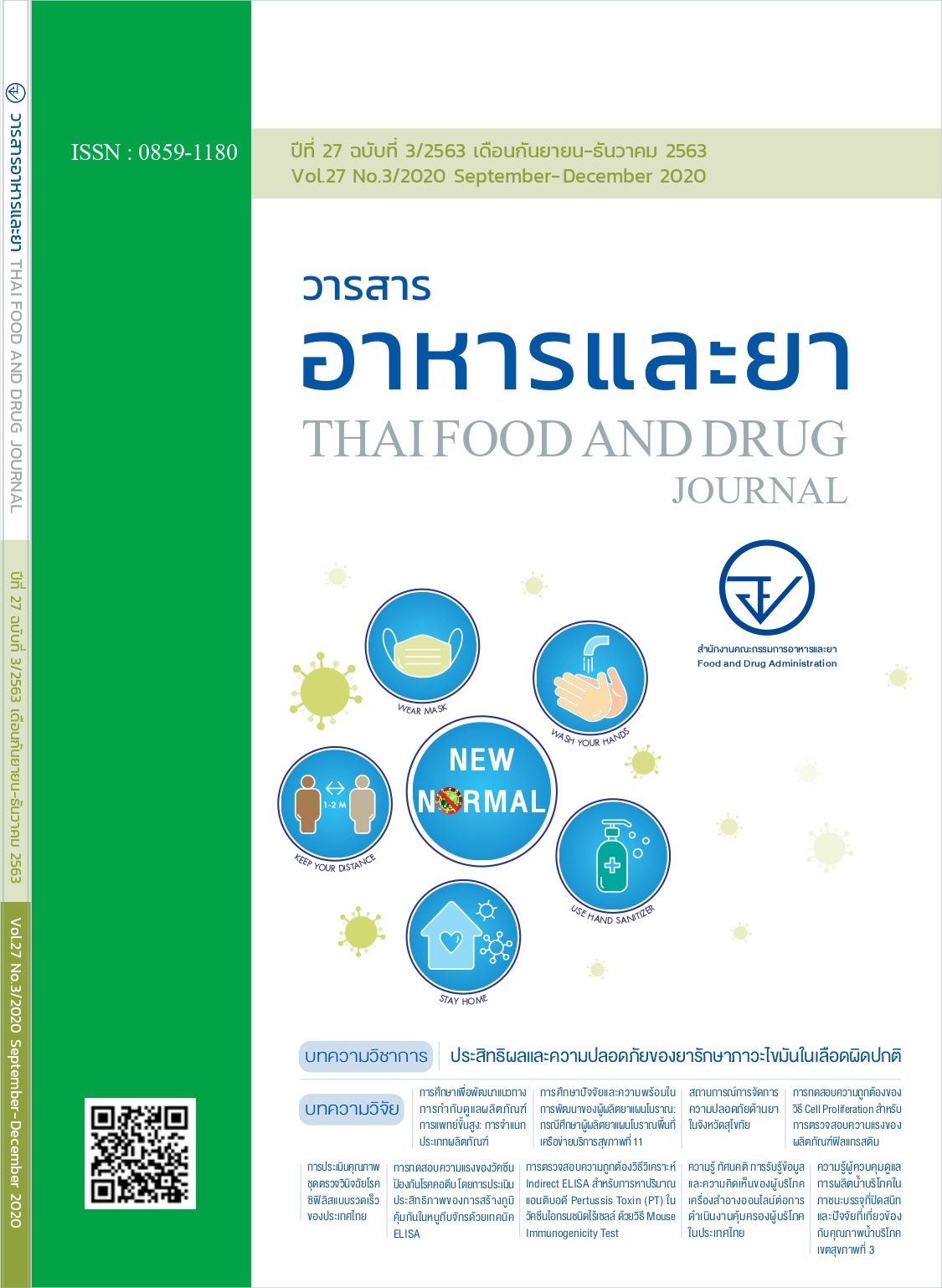สถานการณ์การจัดการความปลอดภัยด้านยาในจังหวัดสุโขทัย
Main Article Content
บทคัดย่อ
การวิจัยเชิงสำรวจเพื่อศึกษาสถานการณ์การจัดการความปลอดภัยด้านยาในจังหวัดสุโขทัย มุ่งเน้นแหล่ง จำหน่ายยาและผลิตภัณฑ์ยา โดยสุ่มตัวอย่างพื้นที่ด้วยการจับฉลากและสุ่มตัวอย่างร้านค้า/ร้านชำ และครัวเรือน แบบบังเอิญ เก็บข้อมูลตั้งแต่ปี 2557-2561 เมื่อประเมินร้านขายยาทุกแห่งในจังหวัดอย่างต่อเนื่อง พบว่า ร้านขายยา บรรจุเสร็จสำหรับสัตว์ และร้านขายยาแผนโบราณ ดำเนินการเกี่ยวกับสถานที่เป็นไปตามมาตรฐาน ผู้ประกอบการ และผู้ประกอบวิชาชีพปฏิบัติตามกฎหมาย ไม่พบผลิตภัณฑ์ยาหมดอายุหรือเสื่อมคุณภาพ ส่วนร้านขายยาแผนปัจจุบันและร้านขายยาแผนปัจจุบันเฉพาะยาบรรจุเสร็จที่มิใช่ยาอันตรายหรือยาควบคุมพิเศษ ผู้ประกอบการทำบัญชีถูกต้อง เป็นปัจจุบันมากขึ้น มีผู้ประกอบวิชาชีพควบคุมกำกับตลอดเวลา และไม่พบผลิตภัณฑ์ยาหมดอายุหรือเสื่อมคุณภาพ
ส่วนร้านค้า/ร้านชำมีการจำหน่ายยาปฏิชีวนะ ยาชุด และยาลูกกลอนลดลง จากร้อยละ 46.07 ในปี 2558 เป็น ร้อยละ 23.61 และ 16.67 ในปี 2559-2560 ตามลำดับ การสำรวจเชิงรุกในครัวเรือนพบยาสเตียรอยด์ลดลง จากร้อยละ 21.00 ในปี 2559 เป็นร้อยละ 2.78 และ 0.00 ในปี 2560-2561 ตามลำดับ ส่วนยาปฏิชีวนะในครัวเรือน ลดลง จากร้อยละ 35.90 เป็นร้อยละ 16.67 และ 5.72 ตามลำดับ การตรวจเชิงรับด้วยชุดทดสอบเบื้องต้นพบ ผลิตภัณฑ์ยามีสารสเตียรอยด์ปนเปื้อนลดลง จากร้อยละ 50.00 ในปี 2560 เป็นร้อยละ 44.44 ในปี 2561 ดังนั้น สำนักงานสาธารณสุขควรร่วมมือกับภาคีเครือข่ายในการควบคุมกำกับแหล่งกระจายยาทั้งในร้านขายยา ร้านค้า รถเร่ ตลาดนัด และอื่นๆ ตลอดจนสุ่มตัวอย่างผลิตภัณฑ์ยาเพื่อตรวจสอบและให้คำแนะนำแก่ประชาชนในการดำเนินการขึ้นทะเบียนยาและมีฉลากยาถูกต้องตามกฎหมาย ไม่มีการจำหน่ายยาชุดและยาที่ปนเปื้อนสารสเตียรอยด์ ที่จะเป็นอันตรายต่อผู้บริโภค ตลอดจนการติดตามการใช้ยาที่บ้านของผู้ป่วยอย่างต่อเนื่อง จะช่วยให้การจัดการ
ความปลอดภัยด้านยามีความยั่งยืน ประชาชนได้รับความปลอดภัยจากการใช้ยาตลอดไป
Article Details
เอกสารอ้างอิง
2. นวเรศ เหลืองใส, ชิดชนก เรือนก้อน. ผลการพัฒนาศักยภาพของอาสาสมัครสาธารณสุขประจำหมู่บ้านในเรื่อง ร้านชำคุณภาพที่ปลอดยาห้ามจำหน่าย.วารสารเภสัชกรรมไทย.2562;11(1):638-47.
3. อัปสร บุญยัง, รุ่งทิวา หมื่นปา. ความชุกของการจำหน่ายยาไม่เหมาะสมของร้านชำในจังหวัดพิษณุโลกและปัจจัยที่มีผล. วารสารเภสัชกรรมไทย 2562;11(3):105-18.
4. พระราชบัญญัติยา พ.ศ. 2510. สำนักงานคณะกรรมการกฤษฎีกา (ลงวันที่ 15 ตุลาคม 2510).
5. กุสาวดี เหลืองนนท์, ศิรินทรา กอแสงเรือง,อัฐวัฒน์ ไชยรบ, ธิติ นพศรี, ยุทธนา จิระศักดิ์พิศาล.การสำรวจยาชุดในจังหวัดปทุมธานี. วารสาร มฉก.วิชาการ 2557;17(34):1-14.
6. ทรงศักดิ์ วิมลกิตติพงศ์, เมษยา ปานทอง. แนวทางการจัดการสู่วิธีปฏิบัติทางเภสัชกรรมชุมชน.[อินเทอร์เน็ต] [เข้าถึงเมื่อ 12 พฤศจิกายน 2562]เข้าถึงได้จาก: http://www.fda.moph.go.th/sites/
drug/GPPPageFile/Operator/ManagementGPP(29Oct2015).pdf
7. ธนพงศ์ ภูผาลี, สมศักดิ์ อาภาศรีทองสกุล, วิษณุยิ่งยอด, ตฤณ แสงสุวรรณ, ลัดดา อำมาตย์. รูปแบบการพัฒนาร้านชำแบบชุมชนมีส่วนร่วม ต.โพนสูง จ.สกลนคร. วารสารอาหารและยา 2562;21(3):57-63.
8. เบญจมาศ บุดดาวงศ์, นิยดา เกียรติยิ่งอังศุลี, ขนิษฐา วัลลีพงษ์, ลัทธิพร บุญมานัส, อรวรรณ กาศสมบูรณ์,จันทร์จรีย์ ดอกบัว, และคณะ.แหล่งต้นทางและการกระจายยาไม่เหมาะสมในชุมชนจาก 8 จังหวัด
สู่ข้อเสนอเชิงนโยบายในการแก้ไขปัญหาการกระจายยาไม่เหมาะสมเชิง วารสารเภสัชศาสตร์อีสาน 2559;11(ฉบับพิเศษ):260-68.
9. ศิริพร จิตรประสิทธิศิริ. ความชุกของการจำหน่ายยาอย่างผิดกฎหมายในร้านชำอำเภอสนามชัยเขตจังหวัดฉะเชิงเทรา. วารสารเภสัชกรรมไทย 2562;11(2):387-396.
10. รุจิรา ปัญญา. ผลของการจัดการปัญหาการใช้ผลิตภัณฑ์สุขภาพปลอมปนสเตียรอยด์ในชุมชนในเขตโรงพยาบาลส่งเสริมสุขภาพตำบลขุนลาน อำเภอดอกคำใต้ จังหวัดพะเยา. วารสารเภสัชกรรมไทย 2562;11(3):553-63.


